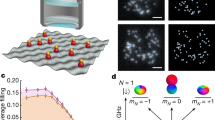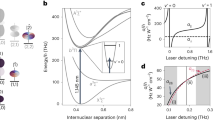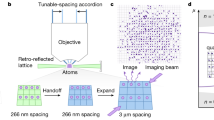Abstract
With the production of polar molecules in the quantum regime1,2, long-range dipolar interactions are expected to facilitate understanding of strongly interacting many-body quantum systems and to realize lattice spin models3 for exploring quantum magnetism. In ordinary atomic systems, where contact interactions require wavefunction overlap, effective spin interactions on a lattice can be mediated by tunnelling, through a process referred to as superexchange; however, the coupling is relatively weak and is limited to nearest-neighbour interactions4,5. In contrast, dipolar interactions exist even in the absence of tunnelling and extend beyond nearest neighbours. This allows coherent spin dynamics to persist even for gases with relatively high entropy and low lattice filling. Measured effects of dipolar interactions in ultracold molecular gases have been limited to the modification of inelastic collisions and chemical reactions6,7. Here we use dipolar interactions of polar molecules pinned in a three-dimensional optical lattice to realize a lattice spin model. Spin is encoded in rotational states of molecules that are prepared and probed by microwaves. Resonant exchange of rotational angular momentum between two molecules realizes a spin-exchange interaction. The dipolar interactions are apparent in the evolution of the spin coherence, which shows oscillations in addition to an overall decay of the coherence. The frequency of these oscillations, the strong dependence of the spin coherence time on the lattice filling factor and the effect of a multipulse sequence designed to reverse dynamics due to two-body exchange interactions all provide evidence of dipolar interactions. Furthermore, we demonstrate the suppression of loss in weak lattices due to a continuous quantum Zeno mechanism8. Measurements of these tunnelling-induced losses allow us to determine the lattice filling factor independently. Our work constitutes an initial exploration of the behaviour of many-body spin models with direct, long-range spin interactions and lays the groundwork for future studies of many-body dynamics in spin lattices.
This is a preview of subscription content, access via your institution
Access options
Subscribe to this journal
Receive 51 print issues and online access
$199.00 per year
only $3.90 per issue
Buy this article
- Purchase on Springer Link
- Instant access to full article PDF
Prices may be subject to local taxes which are calculated during checkout




Similar content being viewed by others
References
Ni, K.-K. et al. A high phase-space-density gas of polar molecules. Science 322, 231–235 (2008)
Ospelkaus, S. et al. Quantum-state controlled chemical reactions of ultracold potassium-rubidium molecules. Science 327, 853–857 (2010)
Micheli, A., Brennen, G. K. & Zoller, P. A toolbox for lattice-spin models with polar molecules. Nature Phys. 2, 341–347 (2006)
Trotzky, S. et al. Time-resolved observation and control of superexchange interactions with ultracold atoms in optical lattices. Science 319, 295–299 (2008)
Greif, D., Uehlinger, T., Jotzu, G., Tarruell, L. & Esslinger, T. Short-range quantum magnetism of ultracold fermions in an optical lattice. Science 340, 1307–1310 (2013)
Ni, K.-K. et al. Dipolar collisions of polar molecules in the quantum regime. Nature 464, 1324–1328 (2010)
de Miranda, M. H. G. et al. Controlling the quantum stereodynamics of ultracold bimolecular reactions. Nature Phys. 7, 502–507 (2011)
Syassen, N. et al. Strong dissipation inhibits losses and induces correlations in cold molecular gases. Science 320, 1329–1331 (2008)
Carr, L. D., DeMille, D., Krems, R. V. & Ye, J. Cold and ultracold molecules: science, technology and applications. New J. Phys. 11, 055049 (2009)
Lahaye, T., Menotti, C., Santos, L., Lewenstein, M. & Pfau, T. The physics of dipolar bosonic quantum gases. Rep. Prog. Phys. 72, 126401 (2009)
Potter, A. C., Berg, E., Wang, D.-W., Halperin, B. I. & Demler, E. Superfluidity and dimerization in a multilayered system of fermionic polar molecules. Phys. Rev. Lett. 105, 220406 (2010)
Gorshkov, A. V. et al. Tunable superfluidity and quantum magnetism with ultracold polar molecules. Phys. Rev. Lett. 107, 115301 (2011)
Yao, N. Y. et al. Topological flat bands from dipolar spin systems. Phys. Rev. Lett. 109, 266804 (2012)
Ospelkaus, S. et al. Controlling the hyperfine state of rovibronic ground-state polar molecules. Phys. Rev. Lett. 104, 030402 (2010)
Chotia, A. et al. Long-lived dipolar molecules and Feshbach molecules in a 3D optical lattice. Phys. Rev. Lett. 108, 080405 (2012)
Lee, P. A., Nagaosa, N. & Wen, X.-G. Doping a Mott insulator: physics of high-temperature superconductivity. Rev. Mod. Phys. 78, 17–85 (2006)
Hazzard, K. R. A., Manmana, S. R., Foss-Feig, M. & Rey, A. M. Far-from-equilibrium quantum magnetism with ultracold polar molecules. Phys. Rev. Lett. 110, 075301 (2013)
Lu, M., Burdick, N. Q. & Lev, B. L. Quantum degenerate dipolar Fermi gas. Phys. Rev. Lett. 108, 215301 (2012)
Aikawa, K. et al. Bose–Einstein condensation of erbium. Phys. Rev. Lett. 108, 210401 (2012)
de Paz, A. et al. Resonant demagnetization of a dipolar BEC in a 3D optical lattice. Phys. Rev. A 87, 051609(R) (2013)
Britton, J. W. et al. Engineered two-dimensional Ising interactions in a trapped-ion quantum simulator with hundreds of spins. Nature 484, 489–492 (2012)
Islam, R. et al. Emergence and frustration of magnetism with variable-range interactions in a quantum simulator. Science 340, 583–587 (2013)
Nipper, J. et al. Atomic pair-state interferometer: controlling and measuring an interaction-induced phase shift in Rydberg-atom pairs. Phys. Rev. X 2, 031011 (2012)
Barnett, R., Petrov, D., Lukin, M. & Demler, E. Quantum magnetism with multicomponent dipolar molecules in an optical lattice. Phys. Rev. Lett. 96, 190401 (2006)
Neyenhuis, B. et al. Anisotropic polarizability of ultracold polar KRb molecules. Phys. Rev. Lett. 109, 230403 (2012)
Martin, M. J. et al. A quantum many-body spin system in an optical lattice clock. Science 341, 632–636 (2013)
Waugh, J. S., Huber, L. M. & Haeberlen, U. Approach to high-resolution NMR in solids. Phys. Rev. Lett. 20, 180–182 (1968)
Maurer, P. C. et al. Room-temperature quantum bit memory exceeding one second. Science 336, 1283–1286 (2012)
Itano, W. M., Heinzen, D. J., Bollinger, J. J. & Wineland, D. J. Quantum Zeno effect. Phys. Rev. A 41, 2295–2300 (1990)
Baur, S. K. & Mueller, E. J. Two-body recombination in a quantum-mechanical lattice gas: entropy generation and probing of short-range magnetic correlations. Phys. Rev. A 82, 023626 (2010)
Quéméner, G., Bohn, J. L., Petrov, A. & Kotochigova, S. Universalities in ultracold reactions of alkali-metal polar molecules. Phys. Rev. A 84, 062703 (2011)
Witzel, W. M., de Sousa, R. & Das Sarma, S. Quantum theory of spectral-diffusion-induced electron spin decoherence. Phys. Rev. B 72, 161306 (2005)
Maze, J. R., Taylor, J. M. & Lukin, M. D. Electron spin decoherence of single nitrogen-vacancy defects in diamond. Phys. Rev. B 78, 094303 (2008)
Acknowledgements
We thank B. Zhu, M. Foss-Feig, G. Quéméner and M. Lukin for discussions. We acknowledge funding for this work from the NIST, NSF, AFOSR-ARO (MURI), ARO, DOE and ARO-DARPA-OLE. S.A.M. is supported by an NDSEG Graduate Fellowship. B.G. and K.R.A.H. are National Research Council postdoctoral fellows. K.R.A.H. and A.M.R. thank the KITP for hospitality.
Author information
Authors and Affiliations
Contributions
The experimental work and data analysis were carried out by B.Y., S.A.M., B.G., J.P.C., D.S.J. and J.Y. Theoretical modelling and calculations were done by K.R.A.H. and A.M.R. All authors discussed the results and contributed to the preparation of the manuscript.
Corresponding authors
Ethics declarations
Competing interests
The authors declare no competing financial interests.
Supplementary information
Supplementary Information
This file contains Supplementary Figures 1-3. Supplementary Figure 1 depicts the dependence of differential light shifts on lattice depth for several rotationally excited states, Supplementary Figure 2 shows the insensitivity of Ramsey contrast oscillations to the confining lattice depth and Supplementary Figure 3 shows the determination of the two-body loss coefficient for a rotational-state mixture. (PDF 200 kb)
Rights and permissions
About this article
Cite this article
Yan, B., Moses, S., Gadway, B. et al. Observation of dipolar spin-exchange interactions with lattice-confined polar molecules. Nature 501, 521–525 (2013). https://doi.org/10.1038/nature12483
Received:
Accepted:
Published:
Issue Date:
DOI: https://doi.org/10.1038/nature12483
This article is cited by
-
Second-scale rotational coherence and dipolar interactions in a gas of ultracold polar molecules
Nature Physics (2024)
-
Properties of a class of quasi-periodic Schrödinger operators
Zeitschrift für angewandte Mathematik und Physik (2024)
-
Collisionally stable gas of bosonic dipolar ground-state molecules
Nature Physics (2023)
-
Tunable itinerant spin dynamics with polar molecules
Nature (2023)
-
Many-body chemical reactions in a quantum degenerate gas
Nature Physics (2023)
Comments
By submitting a comment you agree to abide by our Terms and Community Guidelines. If you find something abusive or that does not comply with our terms or guidelines please flag it as inappropriate.



